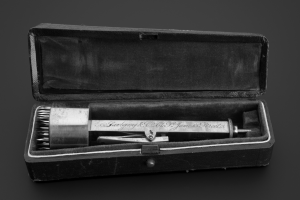- Author
- A.N. Other
- Subjects
- Biographies and personal histories
- Tags
-
- RAN Ships
- None noted.
- Publication
- September 2013 edition of the Naval Historical Review (all rights reserved)
This article has been largely prepared from early newspaper cuttings discovered by Mrs Pat Raymond, an alert South Coast reader, and we thank her for the contribution.
Over a century ago, on Tuesday 10 December 1907, the Sydney Morning Herald carried a story on the funeral of John Browne which took place on that day. What is remarkable about this is that he was 119 years of age.
‘John Browne died peacefully at the Liverpool (NSW) Asylum on the previous Saturday 7 December 1907. In the forenoon he sat up in bed and had his customary smoke and he took his food as usual until the last. About three years earlier he lost his hearing, and some 18 months later had a paralytic stroke, from the effects of which he was confined to his bed. He is said to have formerly belonged to the Royal Navy, and landed in the colony at the age of 32. He entered the asylum 20 years ago, being 99 years of age at the time. He was a well-built man of more than ordinary height, and weighed 16 stone. It is stated that his age was some time ago fully authenticated by the asylum authorities, so that he might safely have been regarded as the oldest man in the Commonwealth and, possibly at this time, the oldest in the world.
There is another reference to him in papers dated 16 November 1904 discovered by the Bega Valley Genealogy Society, which state: Among the ancients of Liverpool Asylum is John Brown (sic), alleged to have been a powder monkey of Nelson’s time. He is said to be now aged 116. According to the asylum records he was born at Canterbury, Kent in August 1788 and served under Nelson at Copenhagen or Trafalgar, or both, the point is not clear. He deserted on one occasion, but was captured and branded according to the cheerful custom of those times. The big ‘D’ is still visible. Stone deaf and nearly blind, his days are spent on his back, his muscles being no longer capable of supporting his frame.
The Liverpool Asylum for the Infirm and Destitute was originally established as a branch of the Sydney Benevolent Society and provided refuge for infirm and destitute men. The institution, later known as the Liverpool State Hospital and Home, closed in 1961.
There is no reference to John Browne or John Brown amongst the list of Trafalgar veterans which matches this description but he could have well served at Copenhagen. If he served as a powder monkey, which was a term reserved for boy seaman of 12 to 14 years of age, this fits nicely with his DOB 1788 and Copenhagen in 1801.

In bygone days Royal Navy deserters were commonly branded with the letter ‘D’ on the hand or forearm. In 1790 the accepted custom of branding using hot irons was changed to the more humane system of tattooing, then using ink or gunpowder to outline the letter. An Army Memorandum dated 25 June 1847 states the marking of deserters is henceforth to take place in hospitals under the supervision of a medical officer and, it is assumed this would similarly apply to the Navy. In the British Medical Journal dated 10 January 1857 an article by J.I. Ikin informs that the branding of deserters with the letter ‘D’ is still practiced with three or four needles tied together and the letter pricked out in the skin under the left arm, a little gunpowder is then rubbed in which has the same effect as tattooing. Mr Ikin then goes on to discuss ways in which deserters try to hide the ‘D’ on attempting to rejoin the forces. The system of tattooing was was not abolished until 1879. A scientific instrument was made for this purpose with vicious needles making the ‘D’ identification. Savigny & Co of 67 St James Street London, surgical instrument makers, produced tattooing instruments and also provided other useful items such as razors, pen quill cutters and bullet extractors.
Acknowledging that Browne was 32 when he first arrived in Australia, this would have been in about 1820, towards the end of Lachlan Macquarie’s governorship. It is possible Browne came out in a naval ship and was discharged or deserted. At this time no warship was dedicated to New South Wales, with HM Ships from the East Indies Squadron making irregular calls at the colony.
Governor Macquarie, a dedicated Army man who had relieved Captain Bligh in strained circumstances, was none too fond of the Navy. During his term of office he reduced reliance on the Royal Navy and in 1820 the only government vessels on station were the small armed sloop Lady Nelson and the colonial cutter Mermaid; both vessels were mainly employed on survey duties. However there was one ship, HMS Dromedary, which had been fitted out for what was an experimental voyage for a naval ship, in transporting convicts. Dromedary dropped down the Thames in August 1819 and took aboard 370 male convicts as well as soldiers and their families. She arrived at Hobart in January 1820 where most of the convicts were discharged; she then spent considerable time in New South Wales, Norfolk Island and New Zealand, not sailing from Port Jackson to England until February 1821. However, there is no record of a John Brown or Browne arriving as a convict at this time.
The 1768 – 1771 Endeavour Journals of Sir Joseph Banks suggests the current trend of tattooing is borrowed from early sailors copying Polynesian customs. Some younger members of society who appear afflicted to an excess of these embellishments could do well to reflect upon John Browne and his unwanted tattoo.’




